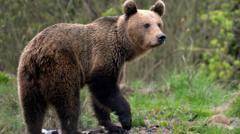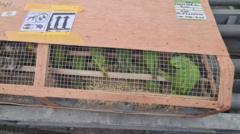This incident underscores the rising concerns over human-wildlife interactions and wildlife management in the region.
Tragic Bear Attack Claims Life of Motorcyclist in Romania's Mountains

Tragic Bear Attack Claims Life of Motorcyclist in Romania's Mountains
A motorcyclist is fatally injured in a bear attack in a popular Romanian tourist destination.
A tragic turn of events unfolded in the picturesque Romanian mountains this Tuesday as a bear fatally attacked a motorcyclist, reports indicate. The victim, who had parked his motorcycle near a warning sign on the scenic Transfagarasan route, was dragged off the road and down an 80-meter ravine. Authorities confirmed his death upon arrival at the scene, mentioning the severity of his injuries despite his use of protective gear, including a helmet.
Ion Sanduloiu, head of the Arges County Mountain Rescue Service, emphasized the critical message for visitors: "Avoid stopping, do not feed the bears, and always maintain a safe distance." Meanwhile, the bear responsible for the attack remains alive, and an investigation is ongoing to ascertain the circumstances of the incident.
Romania boasts the largest population of brown bears within the European Union, with an estimated count of 10,400 to 12,800, a significant increase from earlier estimates. This rising bear encounter frequency has fueled calls for immediate action and reformative strategies in wildlife management. Former environment minister Mircea Fechet has suggested that the bear population could be sustainably reduced to around 4,000, allowing local authorities more leeway in dealing with bears that encroach on residential areas.
Efforts to mitigate bear-human conflicts are also being discussed, with plans for risk zone maps aimed at integrating wildlife conservation with safety concerns. However, some conservationists argue that the underlying issue at play is not merely overpopulation, but rather effective mismanagement. Gabriel Paun from environmental NGO Agent Green noted, "The recurring tragedies stem from poor tourist behavior, insufficient intervention from local authorities, and ineffective implementation of wildlife plans by the national government."
The tragic death of the motorcyclist has ignited discussions on reinforcing penalties for feeding bears and improving safety for both humans and wildlife on Romania's roads.
Ion Sanduloiu, head of the Arges County Mountain Rescue Service, emphasized the critical message for visitors: "Avoid stopping, do not feed the bears, and always maintain a safe distance." Meanwhile, the bear responsible for the attack remains alive, and an investigation is ongoing to ascertain the circumstances of the incident.
Romania boasts the largest population of brown bears within the European Union, with an estimated count of 10,400 to 12,800, a significant increase from earlier estimates. This rising bear encounter frequency has fueled calls for immediate action and reformative strategies in wildlife management. Former environment minister Mircea Fechet has suggested that the bear population could be sustainably reduced to around 4,000, allowing local authorities more leeway in dealing with bears that encroach on residential areas.
Efforts to mitigate bear-human conflicts are also being discussed, with plans for risk zone maps aimed at integrating wildlife conservation with safety concerns. However, some conservationists argue that the underlying issue at play is not merely overpopulation, but rather effective mismanagement. Gabriel Paun from environmental NGO Agent Green noted, "The recurring tragedies stem from poor tourist behavior, insufficient intervention from local authorities, and ineffective implementation of wildlife plans by the national government."
The tragic death of the motorcyclist has ignited discussions on reinforcing penalties for feeding bears and improving safety for both humans and wildlife on Romania's roads.



















